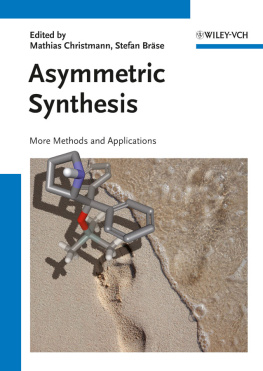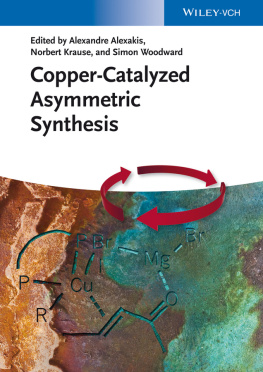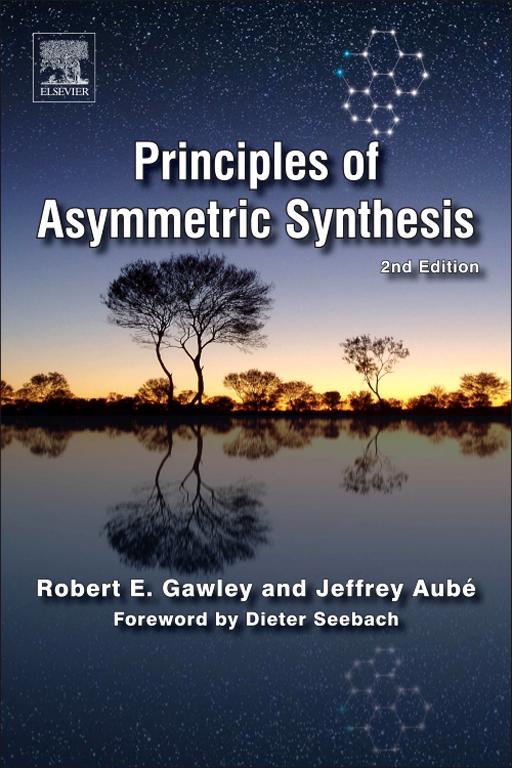Principles of Asymmetric Synthesis
Second Edition
Robert E. Gawley
Department of Chemistry and Biochemistry, University of Arkansas, Fayetteville, AR, USA
Jeffrey Aub
Department of Medicinal Chemistry, University of Kansas, Lawrence, KS, USA

Table of Contents
Elsevier
The Boulevard, Langford Lane, Kidlington, Oxford OX5 1GB, UK
Radarweg 29, PO Box 211, 1000 AE Amsterdam, The Netherlands
First edition 1996
Second edition 2012
Copyright 2012, Professor Robert E. Gawley and Professor Jeffrey Aub. Elsevier Ltd. All rights reserved
No part of this publication may be reproduced, stored in a retrieval system or transmitted in any form or by any means electronic, mechanical, photocopying, recording or otherwise without the prior written permission of the publisher
Permissions may be sought directly from Elseviers Science & Technology Rights Department in Oxford, UK: phone (+44) (0) 1865 843830; fax (+44) (0) 1865 853333; email: , and selecting Obtaining permission to use Elsevier material
Notice
No responsibility is assumed by the publisher for any injury and/or damage to persons or property as a matter of products liability, negligence or otherwise, or from any use or operation of any methods, products, instructions or ideas contained in the material herein. Because of rapid advances in the medical sciences, in particular, independent verification of diagnoses and drug dosages should be made
British Library Cataloguing in Publication Data
A catalogue record for this book is available from the British Library
Library of Congress Cataloging-in-Publication Data
A catalog record for this book is available from the Library of Congress
ISBN: 978-0-08-044860-2
For information on all Elsevier publications visit our website at www.store.elsevier.com
Printed and bound in UK
12 13 11 10 9 8 7 6 5 4 3 2

Dedicated to Lorraine Gawley and Janet Perkins, in appreciation for their love and patience.
Foreword
Dieter Seebach

Chirality in chemistry and asymmetric synthesis (chemical reactions, in which elements of chirality are generated) have developed from a specialty pursued by outsiders (chiromaniacs) to an art cultured by some learned ones, and now are part of essentially every chemists daily life. We should, however, not forget that in a multistep synthesis the transition from achiral intermediates or from racemic mixtures to enantiopure intermediates is unique. In all of the other steps, it is functional-group selectivity, regio- and diastereoselectivity that are at stake.
The development of asymmetric synthesis has taken place exponentially in the last three decades, triggered by a number of circumstances. Many more chemists are intrigued and attracted by the phenomenon of chirality and by the origin of homochirality of the molecules of life. Practitioners of organic synthesis and synthetic methodology have annexed transition-metal chemistry (with chiral ligands on the metals) and biologicalchemical transformations to achieve enantioselective catalysis. Concomitantly, new chromatographic and spectroscopic methods for determining enantiomer ratios have facilitated the ease and accuracy of analyses of products of enantioselective reactions. Perhaps the strongest driving force for the development was the necessity of producing pharmaceuticals, diagnostics, vitamins, and agrochemicals in enantiopure form (their biological targets are chiral, after all!).
As I stated in the foreword of the first edition in 1996, the authors of Principles of Asymmetric Synthesis have managed to cover the subject in a condensed and masterly way; they have chosen well-defined topics for the eight chapters of the book; they have used clear-cut concepts and concise chemical language for the presentations; they have discussed mechanistic considerations with due care; they have included a glossary of stereochemical terms (those to use and those not to use!); they have provided extensive referencing. All of this is still true for the second edition, which has grown from 372 to 556 pages, with an almost doubling of references from ca. 1300 to 2400. This is not due to just adding more of the same but mostly due to including the dramatic new developments that have occurred in the past 15 years.
This can be seen as a realization of two dreams, expressed in 1990 by an organic chemist
As far as the first dream is concerned, there has been a revival of what was called, in 1935, organocatalysis , i.e. catalysis of the classical, main-group organic transformations without involvement of metals or metal ions, using chiral amino compounds, carbenes, Brnsted acids, counter ions, ureas, or HMPA derivatives as catalysts for essentially all the well-known workhorse reactions of organic synthesis, such as aldol, Michael, DielsAlder, 1,3-dipolar additions, hydride transfer from Hantzsch ester, Mannich, Strecker, Stetter, BaylisHillman reactions, -alkylation and -functionalization of carbonyl compounds, FriedelCrafts-type reactions, epoxidations, and aziridinations, to name only a few.
The second dream concerns new types of miracle reactions catalyzed by transition metals that enable the synthetic chemist to perform often incredibly complex transformations in one step, which were undreamed of by experts of classical organic reactions; three Nobel prizes have been awarded in this field in the past decade (2001, 2005, and 2010). A plethora of chiral ligands has become available for enantioselective versions of most of these reactions.
Indeed, inclusion of sections covering organocatalysis (in (dioxiranes, sulfoxidations, BaeyerVilliger and BeckmanSchmidt type reactions).
The second edition of Principles of Asymmetric Synthesis is up-to-date in all aspects of this important part of organic synthesis. Of special note, the first two chapters on Introduction, General Principles, and Glossary of Stereochemical Terms and Practical Aspects of Asymmetric Synthesis are unique among all the books I have seen on stereochemistry. This book can serve as a textbook for classes, as a monograph on enantio- and diastereoselective synthesis, and as a reference work to find seminal publications, even for the expert in the field.
References
1. Seebach D. Angew Chem. 1990;102:1363 Int. Ed. Engl. 1990, 29, 1320.
2. Langenbeck W. Die Organischen Katalysatoren und ihre Beziehung zu den Fermenten Berlin: Springer Verlag; 1935.
Preface
The field of asymmetric synthesis continues to grow at an exponential rate. To even address the topic in a significant way is a formidable task. In the end, we have continued the format of the first edition by selecting several reaction categories that comprise many of the most useful synthetic reaction types. As the title implies, the focus is on the principles that govern relative and absolute configurations in transition state assemblies. There are only a few principles, but they recur constantly. For example, organization around a metal atom, A1,3 strain, van der Waals interactions, dipolar interactions, etc., are factors affecting transition state energies, and which in turn dictate stereoselectivity








